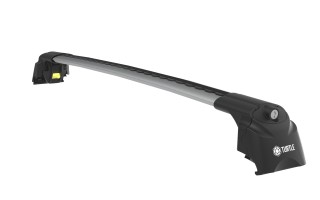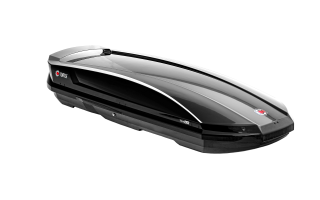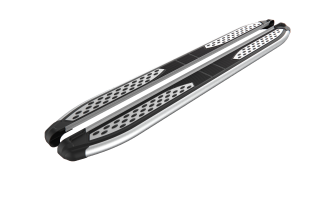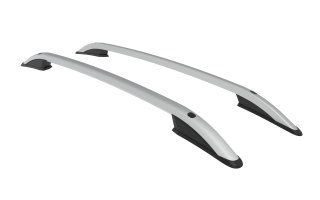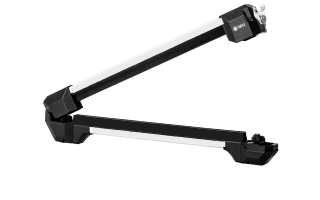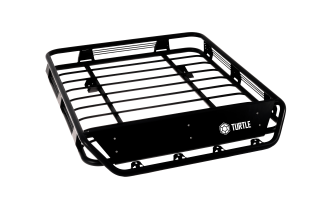There are three main types of carriers you can use to transport bicycles: roof racks, trunk-mounted racks, and towbar-mounted racks. Each of these carriers has different installation methods and specific points to pay attention to. Below, we’ll go through how to install these racks step by step and share important usage tips.
Roof Bike Rack Installation
Roof bike racks allow you to mount your bicycle on top of your car. These types of carriers let you transport your bike without occupying other parts of the vehicle, but incorrect installation may pose some risks.
Step-by-Step Roof Bike Rack Installation
- Check the Roof Rails: First, check whether your car has roof rails. These rails are the primary connection points for mounting the bike rack. If your car does not have rails, you will need to install a roof rail system first.
- Place the Carrier: Carefully place the roof carrier onto the vehicle’s roof. Follow the instructions provided by the manufacturer when attaching the carrier to the rails. Ensure that the carrier sits securely and does not slide.
- Secure the Installation: Use screws and fasteners to tightly secure the carrier to the roof rails. Double-check that all screws are properly tightened and that the carrier does not move.
- Mount the Bicycle: Place the bicycle onto the roof rack. Firmly secure the front and rear wheels, and ensure that the bike does not move in any direction. Make sure the wheels are fastened with straps or clamps on the carrier.
Things to Consider for Roof Bike Racks
- Height Clearance: After mounting the bike on the roof rack, be aware of the vehicle’s total height. Be cautious when entering areas with low clearance, such as garages and underpasses. Calculating the height correctly helps protect both your vehicle and bike from damage.
- Fuel Consumption: Roof racks can affect the aerodynamics of your vehicle, which may lead to increased fuel consumption. If you’re planning a long trip, take this into account when estimating your fuel costs. Maintaining the correct speed and minimizing excess weight can help reduce fuel usage.
Trunk Bike Rack Installation
Trunk bike racks are carriers mounted on the vehicle’s trunk and usually have the capacity to carry multiple bikes. Installation is quite simple, but doing it correctly is very important.
Step-by-Step Trunk Bike Rack Installation
- Open the Rack: Remove the rack from its packaging and carefully read the installation manual. Open the rack and adjust its position to fit securely on the trunk lid.
- Secure the Straps: Fasten the top, bottom, and side securing straps of the rack tightly to the trunk lid. Make sure the straps are firmly secured and that the rack does not move. Incorrectly fastened straps may cause the rack to come loose during the journey.
- Mount the Bike: Place the bike onto the rack. Use the clamps and straps on the rack to ensure the bike stays securely in place. Make sure the bike does not touch the vehicle’s rear window or license plate.
Points to Consider for Trunk Bike Racks
- Rear Visibility: Trunk racks may obstruct your vehicle’s rear visibility. If your vehicle has a rearview camera, ensure the bikes do not block it. Also, make sure the rear window is not partially closed or fogging due to contact.
- License Plate and Lighting: Trunk racks may cover your vehicle’s rear license plate and brake lights. Legally, the plate and lights must be fully visible. In such cases, you may need to use additional license plate and lighting accessories.
Towbar Bike Rack Installation
Towbar bike racks are mounted on the rear of your vehicle and generally have the capacity to carry heavier bikes. Installation is easier compared to other carriers and is usually more secure.
Step-by-Step Towbar Bike Rack Installation
- Attach the Rack: Place the towbar rack onto your vehicle’s towbar. Make sure the rack fits properly and does not move. Close and lock the securing mechanism tightly.
- Mount the Bikes: Place your bikes onto the rack. Use the straps and clamps on the rack to secure each bike individually. Make sure the bikes do not collide with each other and that each one is firmly fastened.
- Check the Lighting Connection: Ensure the lights and signals on the towbar rack are functioning properly. This ensures the rack complies with traffic regulations and increases your safety.
Points to Consider for Towbar Bike Racks
- Weight Limit: Towbar racks have a weight limit, and exceeding this limit may damage both your vehicle and the rack. Therefore, it is important to check the total weight of the bikes placed on the rack.
- Road Clearance: Towbar bike racks can reduce your vehicle’s rear ground clearance. This requires attention, especially when driving over speed bumps, rough roads, and ramps.
Can a Bike Rack Damage the Car?
A properly installed bike rack generally does not damage your vehicle. However, in cases of installation errors, overloading, and improper use, both your car and your bike can be harmed. Being careful during installation and use minimizes these risks.
Important Considerations When Using a Bike Rack
Following certain rules when using bike racks ensures your safety and prevents damage to your vehicle and bicycle.
Weight Limits
Be careful not to exceed the weight limits of your rack and vehicle. Overloading can disrupt the balance of both the rack and your vehicle, potentially leading to accidents.
Speed Limits
When traveling with a bike rack, be mindful not to exceed certain speed limits. Especially at high speeds, the wind resistance caused by the rack may affect your vehicle’s stability.
Wind and Weather Conditions
In windy and bad weather conditions, check the installation of your rack again. Strong winds can affect the bike rack and the bikes, so reduce your speed and drive carefully to ensure safety.
Common Mistakes When Using a Bike Rack
Avoiding certain common mistakes when using bike racks will enhance your safety.
Incorrect Installation
Improperly installing the rack and the bike can cause safety issues and damage to both your vehicle and your bike. Carefully follow the installation instructions and ensure the rack is securely mounted.
Overloading
Loading more bikes than the rack’s capacity can damage the rack, the bikes, and your vehicle. Make sure not to exceed the rack’s capacity and always check the weight limits.
Uneven Placement
Placing the bikes unevenly can create an unbalanced load and pose a danger during driving. Ensure that the bikes are evenly placed and securely fastened.
Insurance and Warranty Coverage When Using a Bike Rack
It is important to be informed about insurance and warranty coverage when using bike racks.
Vehicle Insurance
The bike rack mounted on your vehicle may be included in your insurance policy coverage. However, this can vary depending on the insurance company. Review your insurance policy and check whether your bike rack is covered.
Bike Rack Warranty
Most bike racks come with a specific warranty period. However, if you fail to install or use the rack correctly, you may void the warranty. Follow the manufacturer’s instructions for installation and use to comply with warranty conditions.
Are Bike Racks Prohibited?
The use of bike racks in Turkey is subject to legal regulations. Complying with these regulations is important for your safety and helps you avoid possible legal penalties.
Legal Regulations on Bike Racks in Turkey
When using bike racks in Turkey, your vehicle’s license plate and lights must remain fully visible. Additionally, the rack must not obstruct the rear view of the vehicle, and the installation must be carried out securely—this is a legal requirement.
Legal Considerations When Using a Bike Rack
While using a bike rack, you must pay attention to license plate and lighting requirements. When driving with a rack attached to the rear of your vehicle, make sure that the license plate and lights are completely visible. Also, ensure that your rear view is not blocked once the rack is mounted.
Frequently Asked Questions (FAQs) About Bike Racks
Are Bike Racks Compatible with All Vehicles?
Most bike racks are compatible with various types of vehicles, but you need to choose a model that suits your vehicle’s specific features.
Can Bike Racks Damage the Vehicle?
They don’t cause damage if installed correctly; however, improper installation or overloading can harm the vehicle.
Is There a Speed Limit When Using a Bike Rack?
Yes, it is important to follow the speed limit recommended by the rack manufacturer; generally, it is advised not to exceed 100 km/h.
Can Long-Distance Trips Be Made with Bike Racks?
Yes, but make sure the rack and bikes are securely fastened, and check them regularly
during the journey.
How to Maintain a Bike Rack?
Clean it, prevent rust, regularly inspect straps and fasteners, and lubricate when necessary.


